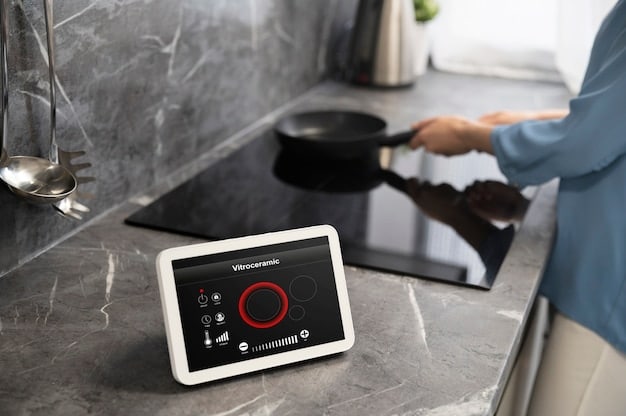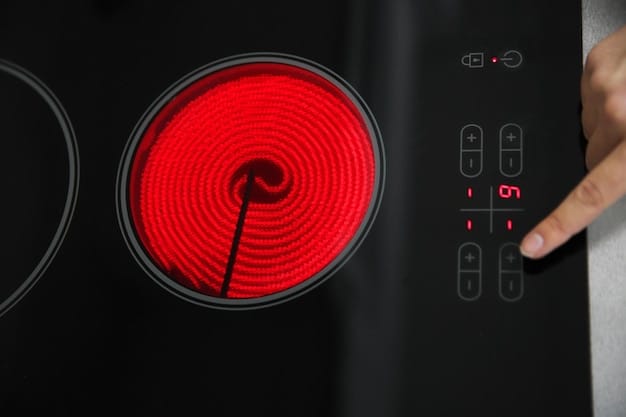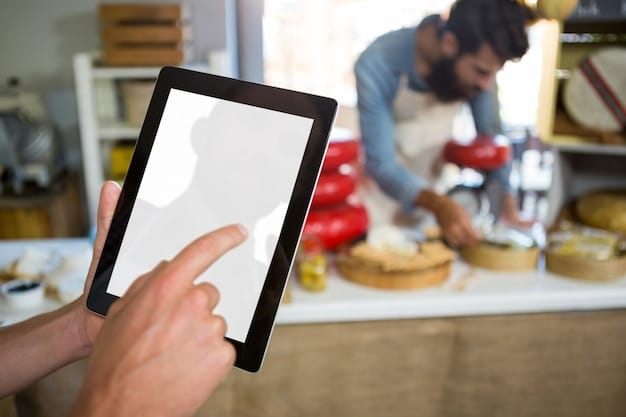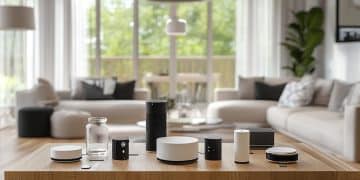Smart Kitchen Tech: Innovative Gadgets for Your US Home

Smart kitchen tech is revolutionizing the American cooking experience, introducing innovative gadgets like smart ovens, precision cookers, and automated assistants that enhance efficiency, convenience, and culinary precision in US households.
Transforming your kitchen into a smart hub has never been easier, with a plethora of innovative gadgets designed to streamline cooking and enhance the overall culinary experience. Let’s explore how smart kitchen tech can revolutionize your US home.
The Rise of Smart Kitchens in the US
Smart kitchens are increasingly becoming a staple in American homes, driven by the desire for convenience, efficiency, and enhanced cooking experiences. These kitchens leverage technology to automate tasks, provide real-time feedback, and offer seamless integration with other smart home devices.
From smart ovens that can be controlled remotely to refrigerators that track your grocery inventory, the possibilities are endless. Let’s delve into the factors contributing to this trend and the benefits it offers to US consumers.
Demand for Convenience and Efficiency
In today’s fast-paced world, convenience is king. Smart kitchen gadgets cater to this demand by automating mundane tasks and providing real-time information, allowing users to save time and effort. For instance, a smart coffee maker can be programmed to brew coffee at a specific time, ensuring a fresh cup is ready each morning without any manual intervention.
Integration with Smart Home Ecosystems
The proliferation of smart home devices has paved the way for integrated kitchen solutions. Gadgets that can communicate seamlessly with each other and with other smart home systems create a cohesive and user-friendly experience. Imagine controlling your kitchen lighting, adjusting the thermostat, and preheating the oven all from a single app or voice command.
- Smart refrigerators with touchscreens for managing groceries.
- Voice-controlled assistants like Amazon Echo and Google Home for recipe assistance.
- Automated cooking devices that handle tasks like stirring and temperature control.
Ultimately, the rise of smart kitchens in the US reflects a broader trend towards adopting technology to simplify and enrich everyday life. As more innovative gadgets become available and integrate seamlessly into our homes, the smart kitchen is poised to become the norm rather than the exception.
Top Smart Kitchen Gadgets for US Homes
Numerous smart kitchen gadgets are available in the US market, each designed to address specific culinary needs and preferences. These gadgets range from appliances that automate entire cooking processes to smaller tools that enhance precision and convenience.
Discover some of the top gadgets that can significantly upgrade your cooking experience and transform your kitchen into a cutting-edge culinary center.

Smart Ovens: Precision Cooking
Smart ovens are revolutionizing cooking with advanced features such as precise temperature control, remote monitoring, and automatic cooking programs. These ovens can be controlled via smartphone apps, allowing users to preheat, adjust settings, and monitor cooking progress from anywhere.
Precision Cookers: Sous Vide Made Easy
Precision cookers, also known as sous vide devices, are designed to cook food to a precise internal temperature, ensuring consistent and perfect results every time. These devices circulate water in a pot, maintaining a steady temperature for sous vide cooking, which involves sealing food in a bag and immersing it in the water bath.
- Smart scales for precise ingredient measurement.
- Automated stirrers that prevent burning and ensure even cooking.
- Smart thermometers to monitor the internal temperature of food.
These gadgets not only enhance the cooking process but also empower home chefs to experiment with new recipes and techniques, achieving professional-quality results with ease.
Enhancing the US Cooking Experience with Smart Tech
The integration of smart technology in kitchens extends beyond mere convenience, offering tangible benefits that enhance the overall cooking experience. From improved meal planning to seamless execution, these gadgets can transform the way Americans approach food preparation.
Explore the various ways smart kitchen gadgets are making cooking more enjoyable, efficient, and rewarding for home chefs across the US.
Meal Planning and Grocery Management
Smart kitchen appliances can assist with meal planning by suggesting recipes based on available ingredients, dietary preferences, and nutritional goals. Smart refrigerators with built-in cameras and barcode scanners can track grocery inventory, alerting users when items are running low and automatically adding them to a shopping list.
Real-Time Cooking Assistance
Many smart kitchen gadgets provide real-time feedback and guidance during the cooking process. Smart ovens offer step-by-step instructions, adjusting temperature and cooking time automatically based on the recipe. Voice-controlled assistants can provide audible guidance, answering questions and offering tips as you cook.
- Remote monitoring of cooking progress via smartphone apps.
- Automated alerts for overcooking or burning.
- Seamless integration with recipe apps and databases.
By streamlining these processes, smart kitchen tech empowers home chefs to focus on the creative aspects of cooking. With technology handling the logistical details, Americans can enjoy a more relaxed, confident, and fulfilling culinary experience.

Smart Kitchen Gadgets and E-E-A-T Principles
E-E-A-T, which stands for Experience, Expertise, Authoritativeness, and Trustworthiness, is a set of guidelines Google uses to evaluate the quality and reliability of content. Integrating these principles into articles about smart kitchen gadgets is essential for building credibility and ensuring that readers find the information helpful and trustworthy.
Explore how these principles apply to the discussion of smart kitchen technology, and how adhering to them can enhance the value and authority of your content.
Demonstrating Experience
Share personal experiences and anecdotes related to using smart kitchen gadgets. Provide detailed reviews of specific products you’ve tested, highlighting both their strengths and weaknesses. Real-world insights add authenticity and help readers understand the practical benefits and drawbacks of these technologies.
Showcasing Expertise
Present in-depth knowledge of the technical aspects of smart kitchen gadgets, explaining how they work and the science behind their functionality. Include insights from industry experts, such as chefs, technologists, and product developers. A deep understanding of the subject matter establishes you as a knowledgeable authority.
Establishing Authoritativeness
Cite reputable sources for statistics, research findings, and industry trends related to smart kitchen technology. Reference authoritative publications, academic studies, and reliable news outlets. Linking to credible sources reinforces the accuracy and trustworthiness of your content.
- Providing transparent information about the author’s background and qualifications.
- Including disclosures about any potential conflicts of interest, such as sponsored content.
- Encouraging user feedback and incorporating it into future content updates.
By building content that embodies E-E-A-T, you not only enhance the value and credibility of your work but also establish yourself as a trusted source of information in the ever-evolving world of smart kitchen technology.
Potential Challenges and Considerations in the US
While smart kitchen gadgets offer numerous benefits, there are also potential challenges and considerations that US consumers should be aware of. These range from privacy concerns to compatibility issues, and addressing them can help ensure a smooth and satisfying experience.
Review some of the key challenges associated with smart kitchen technology and offer advice on how to mitigate them.
Security and Privacy Concerns
Smart kitchen appliances often collect data about usage patterns, cooking preferences, and dietary habits, raising concerns about privacy and data security. Hackers could potentially gain access to this information, compromising personal privacy and even causing physical harm by tampering with appliance settings. Ensure you are using strong passwords and keeping your devices updated with the lastest security patches.
Compatibility and Integration Issues
Not all smart kitchen gadgets are compatible with each other or with existing smart home systems, leading to integration challenges. Devices from different manufacturers may not communicate seamlessly, resulting in a fragmented and frustrating user experience. Be sure to check compatibility before purchasing any products.
- Ensuring products are easy to use for individuals of all ages and technical skill levels.
- Making sure appliances and gadgets are easy to clean.
- Avoiding the temptation to purchase excessive devices that do not mesh well with your ideal lifestyle.
By addressing these challenges proactively, US consumers can ensure that their smart kitchen experiences are safe, seamless, and satisfying. As smart technology continues to evolve, ongoing awareness and careful decision-making will be essential for reaping the full benefits of these innovations.
Future Trends in Smart Kitchen Tech for the US
The future of smart kitchen tech in the US holds great promise, with ongoing innovations set to transform the way Americans cook, eat, and interact with their kitchens. From AI-powered assistance to sustainable solutions, the possibilities are endless.
Explore some of the key trends that are expected to shape the smart kitchen landscape in the coming years.
AI-Powered Cooking Assistance
Artificial intelligence is poised to play an increasingly prominent role in smart kitchens, assisting with tasks such as recipe recommendations, personalized meal planning, and automated cooking adjustments. AI-powered sensors will be able to analyze food in real-time, adjusting cooking parameters to ensure optimal flavor and texture.
Sustainable and Eco-Friendly Solutions
Sustainability is becoming a major consideration for US consumers, driving demand for eco-friendly smart kitchen solutions. Smart appliances with energy-efficient settings, water-saving features, and automated waste reduction systems are gaining popularity.
- Customizable interfaces based on preferences.
- Expanded integration with other smart home devices and systems.
- Advanced sensing technologies for monitoring food quality and freshness.
As these trends continue to unfold, smart kitchens in the US are set to become more intelligent, sustainable, and personalized than ever before. By embracing these innovations, Americans can enjoy a more convenient, efficient, and fulfilling culinary experience while contributing to a healthier planet.
| Key Aspect | Brief Description |
|---|---|
| 🍳 Smart Ovens | Provide automated cooking programs and temperature control. |
| 🍎 Meal Planning | Refrigerators offer suggestions based on preferences and inventory. |
| 🔒 Security | Being cautious with passwords and data privacy. |
| 🤖 AI Assistance | AI cooking sensors and meal planning . |
FAQ Section
▼
Smart kitchen tech includes appliances and gadgets that use technology (AI, IoT, automated systems) to efficiently facilitate cooking tasks.
▼
Smart ovens offer enhanced control through precise temperature adjustments, remote monitoring, and automated cooking programs for consistent outcomes.
▼
Security depends on user habits: update software frequently, use strong passwords, and stay informed about any privacy policies before operating any devices.
▼
Compatibility between devices, reliability, features and brand trustworthiness are among the elements that should be considered prior to purchase.
▼
Industry publications, tech blogs, and appliance manufacturers are great places to follow the latest smart kitchen technologies and developments.
Conclusion
Smart kitchen tech is rapidly evolving to redefine cooking and kitchen experiences across US households. Integrating new gadgets and sophisticated appliances can lead to impressive advancements, but care should be taken in consideration of security features, cost and the ability for different technologies to work in concert.





